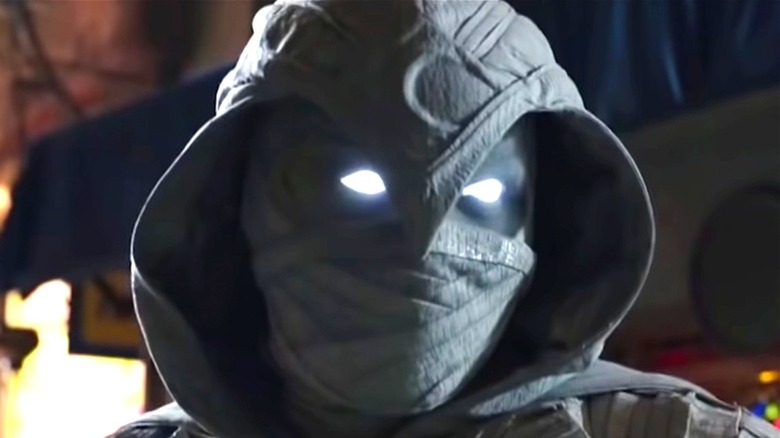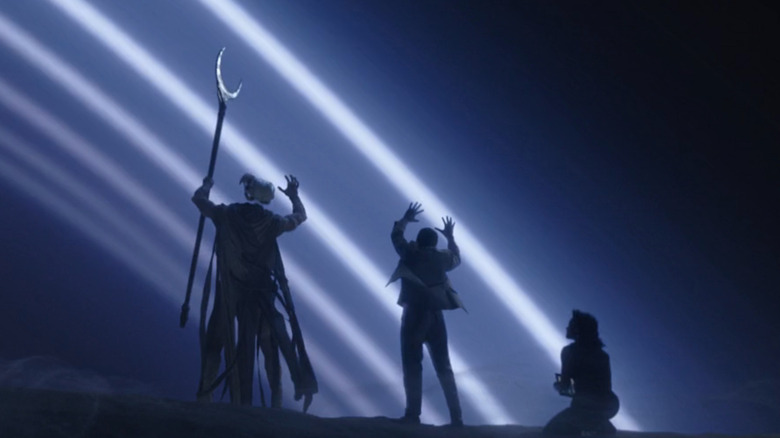How Accurate Is The Celestial Navigation In Moon Knight Episode 3?
"Moon Knight" has already proven to be a globe-trotting journey, standing out from the Marvel Cinematic Universe's other Disney+ series by telling a story that blends multiple influences. The trappings of an "Indiana Jones"-style treasure hunting adventure are on full display, but the psychological component of Marc Spector (Oscar Isaac) sharing a body with multiple other personalities, most notably the mousey Steven Grant, makes for even more compelling storytelling since anything can happen from moment to moment. Additionally, the show builds on that by fully committing to the more mystical elements of Egyptian mythology. As director Mohamed Diab told Looper, one of the series' goals was to offer a realistic look at Egypt.
One of the most stunning moments in "Moon Knight" happens toward the end of Episode 3. Having lost the golden scarab which points toward Ammit's tomb, Layla (May Calamawy) and Marc/Steven are now racing the clock to find it before Arthur Harrow (Ethan Hawke) manages to unleash the ancient god. They manage to acquire a star map from a sarcophagus, but it proves beyond Marc's skill set, so he gives Steven control of their body to solve the puzzle. Once the map is assembled, however, there's another hiccup. In the thousands of years since the map was made, the stars have shifted in the sky, making the map useless unless there's a way to see how the night sky looked back then.
Together with Steven, Khonshu rewinds the celestial clock until the stars are back in the positions they occupied when the map was created. Using his powers prompts the other gods to imprison him in a stone statuette as punishment, but Steven holds the spell for long enough that Layla figures out where they need to go next.
It's a stunning scene aesthetically, but how scientifically accurate is it?
Moon Knight nails ancient Egyptian astronomy
As it turns out, "Moon Knight" managed to be historically and scientifically accurate with its star charting scene. To begin with, the star map used in the show was a common form of navigation for ancient Egyptians, and finding it in a sarcophagus makes sense, too, since such astronomical information was commonly placed in tombs to help the dead navigate in the afterlife (via Scientific American). As for the phenomenon of stars drifting over time, that's also accurate. Not only is Earth constantly in motion, but so is our entire galaxy. Star drift isn't visible in a human lifespan, but the night sky changes drastically over thousands of years. Polaris, the North Star we see today, didn't become the most prominent star in the sky until a few thousand years ago, and for ancient Egyptians, the North Star would have been Thuban (via NASA).
So, if you were Khonshu and wanted to rewind the stars, would it look anything like what we see in "Moon Knight?" The VFX team clearly did their homework because they got that right, too. Like the Sun and Moon, stars appear to move from East to West from the perspective of someone on Earth due to the direction of our planet's rotation (via National Radio Astronomy Observatory). When Khonshu reverses the stars in "Moon Knight," they move rapidly in the opposite direction, which is how it would look if that power existed in real life.
The only issue with the scene is the fancy tablet Layla uses to photograph the rewound stars. Assuming the tablet has an internet connection, there are plenty of astronomy databases that could have shown her what the stars looked like at any given point in time, and none of them require the powers of a moon god to access.

